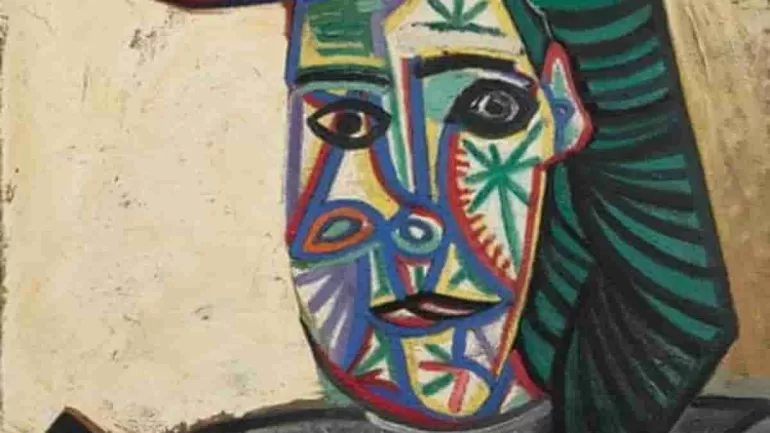ART AUCTION
A long-lost Picasso portrait of Dora Maar is headed to auction after being hidden for nearly a century. Discover the history behind this remarkable find.
BY ARTCENTRON NEWS
After nearly a century in the shadows, a forgotten canvas by Pablo Picasso is once again in the public eye. The painting, a haunting portrait of his muse and artistic confidante, Dora Maar, will now take center stage at the French auction house Lucien Paris. Expectations are that this Picasso portrait of Dora Maar will attract significant attention from art collectors and enthusiasts.
The History of the Lost Picasso Portrait of Dora Maar
Painted in war-torn 1943, this work, titled Buste de femme au chapeau à fleurs (Dora Maar), was quickly acquired by a private collector and remained in their possession for decades. Before it vanished, the painting was only glimpsed in two sepia-toned photos captured by the photographer Brassaï in 1944, showing the canvas tucked away in Picasso’s studio. These photographic relics now serve as its official validation, carefully preserved in the auction’s dossier.
The upcoming sale on October 24 in Paris’s historic Hôtel Drouot carries a speculative price tag of around €8 million ($9.5 million). Though a significant sum, it’s a distant echo of the artist’s record-breaking Les femmes d’Alger (Version ‘O’), which sold for $179.4 million in 2015.
This floral-crowned effigy of Maar is one of many Dora Maar paintings by Picasso that emerged during the twilight of their affair. It casts a quieter sorrow compared to his famed Weeping Woman series of 1937, in which she appears fractured and inconsolable, an emotional echo chamber of despair.
Auctioneer Christophe Lucien described the painting as a “resplendent anomaly.” According to him, it’s both a seminal artifact of 20th-century art and a whispered page from Picasso’s fevered intimacy. “To uncover this work,” he mused, “is akin to beholding a spectral visitation.” The auction house hopes this painting by Picasso will captivate bidders.
The Complex Relationship Between Picasso and Maar
Maar—who by 1936 had already carved her name into the annals of photographic and Surrealist innovation—has seen a retrospective bloom in scholarly and curatorial attention. The Tate Modern’s 2019 tribute reinstated her as a vanguard within Surrealism’s roiling milieu. In 2024, London’s Amar Gallery showcased her photograms and ethereal studies. Her lenswork also adorned the halls of the Dalí Museum in Florida. These artworks reveal the eye behind the documentation of Guernica, Picasso’s lamentation on war, of which she was the appointed chronicler.
During the Nazi stranglehold on France, Picasso was denounced as “degenerate” and exiled from exhibition halls. However, he persisted, brush in hand. It was within this fraught crucible that Buste de femme au chapeau à fleurs came into being. It is a product of both historical duress and intimate fracture. That same year, Picasso’s emotional tether to Maar unraveled. Their parting was intensified by his increasing cruelty and burgeoning entanglement with Françoise Gilot. The separation fractured Maar’s psyche to such an extent that she sought salvation through Jacques Lacan. Lacan controversially administered electroshock therapy—a violation of medical ethics scarcely discussed.
While immortalized through Picasso’s anguished renderings, Maar scorned his depictions. “They’re all Picassos. Not one is Dora Maar,” she once said, slicing through the myth with brutal clarity. Biographer John Richardson wrote that, by then, Dora had become Picasso’s human elegy. She was a living effigy of his inner cataclysm, painted not as a muse, but as a martyr. The sale of this Picasso portrait of Dora Maar reignites conversation about their complex relationship.
Haunting Picasso Portrait of Dora Maar: A Broader Context
This rediscovered Picasso portrait of Dora Maar steps back into the limelight at a moment when Picasso’s theatricality is again under dissection. The Tate Modern’s Theatre Picasso exhibition—a centenary homage to his seminal Three Dancers (1925)—is insightful. It explores his enchantment with performers and pageantry. Curated by polymathic duo Wu Tsang and Enrique Fuenteblanca, the show offers a lens into the carnival of personas that haunted Picasso’s imagination. This new exhibition provides context for the upcoming auction of the Picasso portrait of Dora Maar.
Yet none linger so hauntingly as Dora. And now, with brushstrokes long silent, her portrait speaks once more. A relic of war, art, love, and betrayal, exhumed from secrecy to be judged anew by the world. The re-emergence of this Picasso portrait of Dora Maar is a poignant event in the art world.
- Featured Image: Pablo Picasso, Buste de femme au chapeau à fleurs (Dora Maar) (1943). Image: Lucien Paris.
